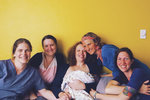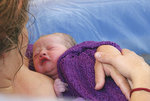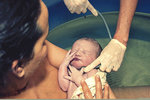



Amy Schrater curls up on her living room couch and nuzzles her newest baby, 13-day-old Gretchen. Waking briefly from her lovely, just-nursed, newborn slumber, Gretchen stretches, her hand grazing her mom’s chest, a sleepy smile on her tiny face, and coos her contentment.
“She’s such a mellow, sweet, happy baby,” Schrater says, kissing her daughter’s head, and gazing at Gretchen with a look of pure love.
In this beautiful Yacolt house, with its sun-filled, high-ceilinged rooms, both mother and baby are settling into a sweet, slow, age-old routine. A feeling of peace surrounds the duo and permeates the living room.
“It made the house feel extra special,” Schrater says, referring to Gretchen’s birth, which took place less than two weeks before, in a waterbirth tub inside her parents’ bedroom, her three siblings, mom, dad and a small gaggle of midwives welcoming her into this world. “For my older kids, it was wonderful. They were a part of the birth. It wasn’t like, ‘Oh, now we’re going to go visit mom and our new baby sister in the hospital.’ She was already here. She was just another member of the family.”
For Schrater, 36, the decision to have a home birth did not come easily. As an emergency room nurse trained to think about all of life’s “what ifs,” Schrater had always felt more comfortable giving birth in a medical environment.
She used certified nurse midwives at a hospital-based birth center for her first two births – to 10-year-old Jack and 7-year-old Miriam – and had required an emergency cesarean section with her third baby, 4-year-old Luke. Schrater had loved the nurse midwives at Pacific Midwifery in Vancouver, who helped with her first three births, but when she became pregnant with Gretchen, home birth was on her mind.
“We had moved out here (to a home in between Battle Ground and Yacolt, off Lucia Falls Road) in August, and my other births had been fast – six hours with the first, four hours with the second and then a c-section with Luke – so I didn’t know if we would make it to the hospital for this one,” Schrater says.
After researching midwife-assisted home birth and talking to her husband, Joe Schrater, a firefighter-paramedic with the Vancouver Fire Department, Schrater decided to have her fourth baby at home.
“I really researched it,” Schrater says. “I wanted to make sure this was the right decision.”
Nine months and one very sweet baby later, Schrater says birthing at home opened her eyes to something glorious.
“The whole experience was so different,” she says. “My midwives would come here and visit me … they really listened and spent hours with me, taking care of me. I felt like I was in this village, like this was the way it was meant to be. And I realized that I’d robbed myself of this beautiful thing (with past births).”
“Just as safe, if not safer”
Just a few days after attending Gretchen’s birth, Woodland midwife Adeline Kell is still on a high, remembering the Schrater family’s intense joy.
“Having the older kids there, watching the looks on their faces … it was such a beautiful moment,” Kell says. “It was a wonderful birth.”
As a naturopathic doctor, licensed midwife and the mother of six children, Kell is no stranger to birth. And she knows one thing for sure: Birth works better when the mother feels safe.
“If you feel safe, everything goes better: Birth, postpartum, breastfeeding,” Kell says.
For more and more women in Clark County, birthing at home is the best way to ensure that feeling of safety.
“So many women feel traumatized by their births,” Kell says. “And we get a lot of moms who have already given birth in a hospital setting, maybe with a lot of interventions, and are looking for something different.”
National research backs the safety of birthing at home with an experienced midwife. In fact, many new studies show that midwife-assisted home births are just as safe – if not safer – than birthing at the hospital. Women who birth at home with a midwife are much less likely to have induced labors, episiotomies and cesarean sections (C-section). They are also more likely to have better birth outcomes, shortened recovery times and higher rates of breastfeeding.
According to the American College of Obstetricians and Gynecologists, there are four deaths for every 100,000 women who give birth vaginally in the United States. This rate jumps to 13 deaths per 100,000 women with C-section births. At most hospitals, the C-section rate hovers around 35 percent. For home births, the C-section rate is typically between five and 10 percent – much closer to what the World Health Organization has said is optimal for mothers and babies in the U.S.
“All of the retrospective studies show that (planned, midwife-assisted) home birth is just as safe, if not safer, for mom and baby,” Kell says. “Certainly, there are fewer C-sections. And the true risk of having a C-section, for mothers, is way underreported.”
As a naturopathic doctor, Kell is able to use a variety of healing tools – including nutrition, herbs and homeopathic remedies – to treat and prevent things like anemia and high blood pressure that can trip up a healthy pregnancy and birth.
Licensed midwives are trained for a variety of birth emergencies and usually carry life-saving equipment and drugs to treat postpartum hemorrhages. However, when situations arise that require a laboring woman to transfer to the hospital for a C-section or emergency treatment, midwives don’t hesitate.
“Sometimes things happen,” Kell says. “If it’s an emergency, there is no right or wrong, we don’t wait.”
In recent years, many hospitals have opened to the idea of working with licensed midwives to help women have optimal birth experiences. Many hospitals employ certified nurse-midwives and have specialized birth clinics that offer waterbirth and rooms that are less clinical and more like home. In Clark County, Kell says the Legacy Salmon Creek Medical Center does a fantastic job with birthing mothers and that the doctors and nurse-midwives at that hospital are very easy to work with when home births require a transfer to the hospital.
“Legacy has gone out of their way to welcome us,” Kell says. “Even with transfers, when it’s done right, it can be a very beautiful experience for the moms. Our goal is not to stay at home no matter what. Our goal is always to have a safe outcome for mom and baby.”
Strong demand for home birth midwives in Clark County
Across Clark County, women are starting to crave the same type of empowering experience Schrater had with Gretchen’s home birth.
Popular television shows like the BBC’s “Call the Midwife,” and movies like actress Ricki Lake’s 2008 documentary film, “The Business of Being Born,” have helped normalize home birth and highlighted the many benefits of giving birth naturally.
“Ricki Lake really opened people’s eyes,” says Vancouver-based midwife Angela Beach-Hart. “A lot of the mothers who come to us were unhappy with their birth experiences in the hospital. They often feel like they didn’t have a lot of informed choice with their first births.”
What’s more, says Kell, under Washington state law, insurance providers cannot legally restrict a woman’s choice of birth location. If a Washington woman wants to give birth at home and her insurance plan lacks access to a doctor or nurse-midwife willing to attend a home birth, her insurance company is required to pay for a midwife or naturopathic doctor who will assist her birth at home.
Even with insurance options opening up for women who desire home birth, access to licensed midwives, especially in Clark County, is limited.
Beach-Hart and Kell – along with Alexandra Demetro, a Battle Ground naturopathic doctor and licensed midwife – run the Birth, Babies and Beyond midwifery group. Aside from a few traditional, unlicensed midwives who often practice within the religious, Apostolic community – as well as a limited number of Portland midwives who have obtained their Washington license and are willing to make the drive – the Birth, Babies and Beyond midwives are the only game in town when it comes to home birth in Clark County.
The Birth, Babies and Beyond midwives joined forces about 18 months ago. As a group, the midwives can cover a larger geographic area and take on more clients.
“We like to stick with only four clients a month, but there is a strong demand in this area,” Kell says. “Sometimes we can take on a fifth … but, often, we have to turn people away.”
The midwives’ Clark County clients skew across all spectrums – many clients hail from the area’s cloistered, highly religious Apostolic community; others are tattooed hipsters who have moved from Portland or Seattle in search of a more rural place to raise their children; while some clients are living on farms and trying to live a very natural, back-to-Earth kind of life.
“It’s such a mix,” Beach-Hart says of the women she and her sister midwives serve in Clark County. “But we try to meet each woman where she’s at.”
Schrater attests to this. She and her husband Joe are very much in touch with their Christian faith and wanted to have prayer and Christian worship music at Gretchen’s birth. All of the Birth, Babies and Beyond midwives were very attuned to the Schraters’ spiritual needs and helped them have the birth they wanted, Schrater says.
“They didn’t have their way of doing it,” Schrater says. “This was my experience and – as long as it was safe – they were willing to let me do things my way. It was very empowering. Really, it was everything I could have hoped for.”
To learn more about the home birth midwives at BIrth, Babies & Beyond, visit www.birthbabiesbeyond.com.